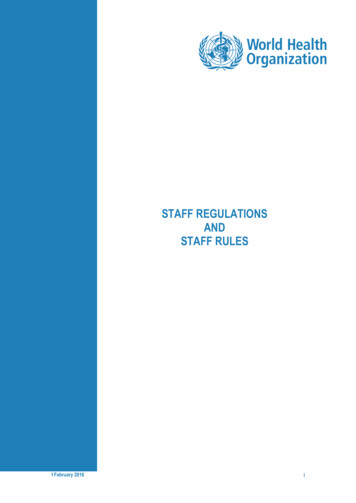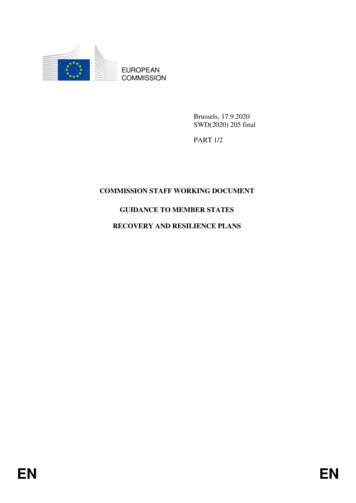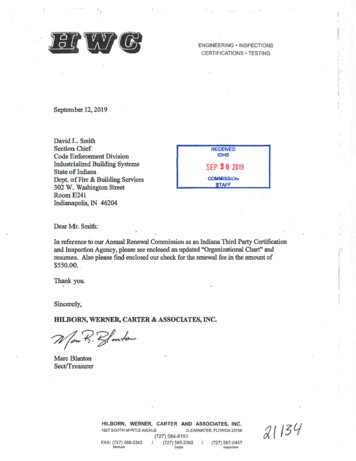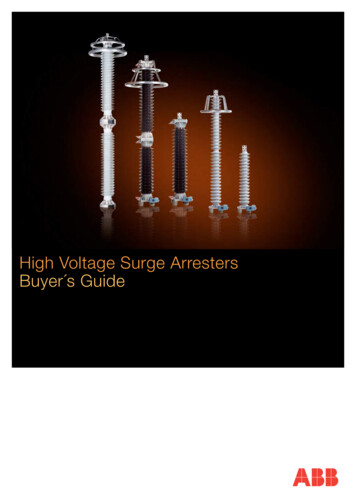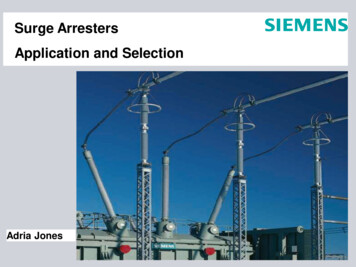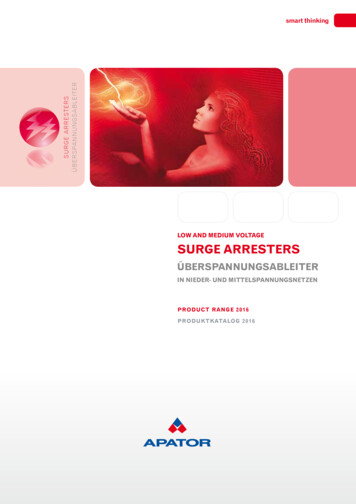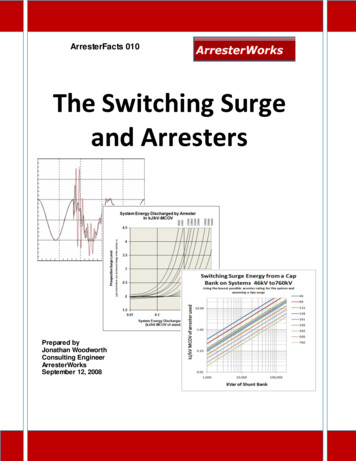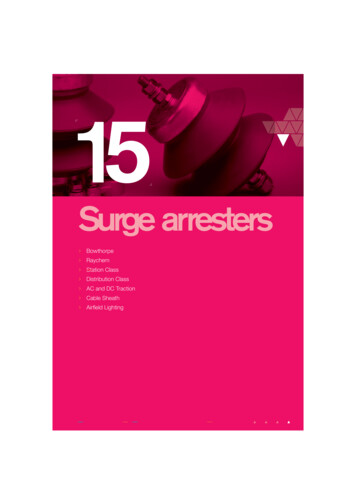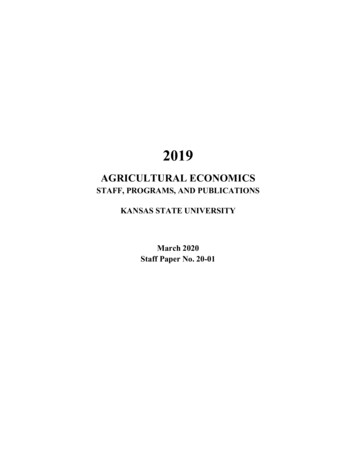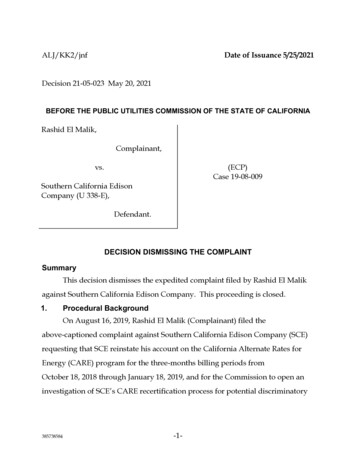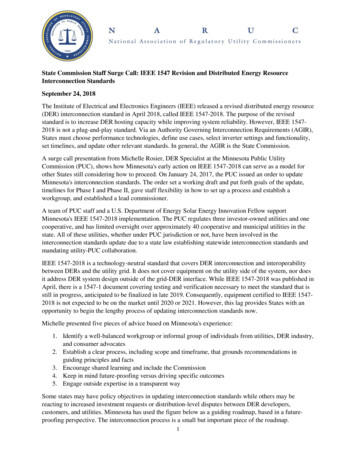
Transcription
State Commission Staff Surge Call: IEEE 1547 Revision and Distributed Energy ResourceInterconnection StandardsSeptember 24, 2018The Institute of Electrical and Electronics Engineers (IEEE) released a revised distributed energy resource(DER) interconnection standard in April 2018, called IEEE 1547-2018. The purpose of the revisedstandard is to increase DER hosting capacity while improving system reliability. However, IEEE 15472018 is not a plug-and-play standard. Via an Authority Governing Interconnection Requirements (AGIR),States must choose performance technologies, define use cases, select inverter settings and functionality,set timelines, and update other relevant standards. In general, the AGIR is the State Commission.A surge call presentation from Michelle Rosier, DER Specialist at the Minnesota Public UtilityCommission (PUC), shows how Minnesota's early action on IEEE 1547-2018 can serve as a model forother States still considering how to proceed. On January 24, 2017, the PUC issued an order to updateMinnesota's interconnection standards. The order set a working draft and put forth goals of the update,timelines for Phase I and Phase II, gave staff flexibility in how to set up a process and establish aworkgroup, and established a lead commissioner.A team of PUC staff and a U.S. Department of Energy Solar Energy Innovation Fellow supportMinnesota's IEEE 1547-2018 implementation. The PUC regulates three investor-owned utilities and onecooperative, and has limited oversight over approximately 40 cooperative and municipal utilities in thestate. All of these utilities, whether under PUC jurisdiction or not, have been involved in theinterconnection standards update due to a state law establishing statewide interconnection standards andmandating utility-PUC collaboration.IEEE 1547-2018 is a technology-neutral standard that covers DER interconnection and interoperabilitybetween DERs and the utility grid. It does not cover equipment on the utility side of the system, nor doesit address DER system design outside of the grid-DER interface. While IEEE 1547-2018 was published inApril, there is a 1547-1 document covering testing and verification necessary to meet the standard that isstill in progress, anticipated to be finalized in late 2019. Consequently, equipment certified to IEEE 15472018 is not expected to be on the market until 2020 or 2021. However, this lag provides States with anopportunity to begin the lengthy process of updating interconnection standards now.Michelle presented five pieces of advice based on Minnesota's experience:1. Identify a well-balanced workgroup or informal group of individuals from utilities, DER industry,and consumer advocates2. Establish a clear process, including scope and timeframe, that grounds recommendations inguiding principles and facts3. Encourage shared learning and include the Commission4. Keep in mind future-proofing versus driving specific outcomes5. Engage outside expertise in a transparent waySome states may have policy objectives in updating interconnection standards while others may bereacting to increased investment requests or distribution-level disputes between DER developers,customers, and utilities. Minnesota has used the figure below as a guiding roadmap, based in a futureproofing perspective. The interconnection process is a small but important piece of the roadmap.1
Source: g%208312016.pdf.Phase I updated Minnesota's interconnection process, applications, and agreements. It involved fifteenorganizations including engineers, Commission staff, lawyers, and consumer advocates meeting fivetimes in person throughout 2017. Phase I produced draft staff recommendations. In Phase II, a smallersubgroup with technical expertise made edits to the regulated utilities' technical interconnection andinteroperability requirements proposals from March through October 2018. Draft agendas and prepmaterials were provided to the workgroup in advance of each meeting, and staff encouraged workgroupcollaboration rather than a staff-led process.2
Not all technical requirements in a statewide document come out of IEEE 1547-2018 – there are otherstandards to be considered. Non-utility stakeholders in Minnesota were interested in considering a handfulof items not in IEEE 1547-2018, including: Definition and application of limits to a DER's "capacity" versus nameplate ratingNon-export or limited export; including inadvertent exportMetering requirementsDistribution upgrades for remote control and monitoring1-line diagramsMichelle then turned to Phase II, providing a handful of takeaways for Commission staff:1. Familiarize yourself with IEEE 1547-2018IEEE 1547-2018 is a highly technical document with a lot of detail. The standard focuses on the interfaceand interoperability of DERs. IEEE 1547-2018 takes bulk power system (BPS) impacts and distributionlevel concerns into consideration. It does not address – but can enable – DER integration. Most of all,1547-2018 is just one piece of the larger DER roadmap. There is a difference between DERs and/orinverters having the capability to perform a function versus the DER provider enabling the capability,utilizing it, and reporting the function. 1547-2018 is only about capabilities.Annex B is an informal guide for Commission staff in setting performance categories that can help Staffdecide how to categorize different types of DERs.2. Establish a technical subgroup with utility and DER expertiseDuring Phase II, the utilities authored a document for the working group to edit. Several of the meetingsfocused on learning from the various perspectives of workgroup members. It is important to create aspace where people can ask questions and learn from each other and outside experts, particularly in Stateswith lower DER penetration. The Electric Power Research Institute (EPRI), National Renewable EnergyLaboratory (NREL), and Regulatory Assistance Project (RAP) have all provided valuable technicalassistance to the PUC.3. Work with your regional transmission operator (RTO)/independent system operator (ISO) andneighboring statesDue to BPS considerations, it is important for Commissions to work closely with RTOs and ISOs. ThePUC established contact with the Midcontinent Independent System Operator (MISO) early to find theright person and get critical information. The PUC hosted a workshop with Organization of MISO States(OMS) members to introduce the topics in 1547-2018, but it takes more than one workshop to resolve allthe issues. MISO has developed a work plan on educating members and stakeholders, working withOMS.4. Recognize the elephant in the room (may not be in scope) and frame your process appropriatelyUtilization of IEEE 1547-2018-required capabilities brings up questions on compensation, visibility, anddispute resolution. Commissions have a critical role in consumer protection, utility investments, and tariffdesign. Utilization is not just a concern for consumer protection and compensation – utilities may also be3
unprepared to utilize some of the interoperability and advanced inverter capabilities because of systemdesign or additional investments required.For example, one of the areas of concern for Commissions is volt-watt functionality: if voltage is not inrange, the inverter can change how much active power is produced, impacting project revenue. Anotherarea of concern is frequency response: this functionality requires headroom, holding back powerproduction, in order to produce frequency response. IEEE 1547-2018 was written by technical experts,not regulators, and there are steps missing on enabling utilization.5. Work with technical experts in a transparent wayThe IEEE 1547-2018 author list points Commissions towards resources in their States. IEEE also offersworkshops, including the option to work directly with States to offer customized workshops. Staff are notalone and many resources are available to help. Michelle offered a short list to begin: FERC Small Generator Interconnection Process (SGIP) & Interconnection Agreement dus-act/gi/small-gen.aspNREL Distributed Generation Interconnection Collaborative: https://www.nrel.gov/dgic/Database of State Incentives Renewable Energy (DSIRE) Interconnection type 14&NERC and IEEE Workshop on IEEE 1547-2018 – Sept 26, 2018 in Atlanta, n-eps.htmlIEEE 1547 available for free to all andard/1547-2018.html6. Interim implementation requires considerationUntil there is 1547-2018-certified equipment in 2020 or 2021, Commissions should pay attention to UL1741 certification. UL 1741 was created specifically for Rule 21 in California and Hawaii's 14H rule. Itincludes some but not all of the IEEE 1547-2018 capabilities. States do have the option for interimlanguage rather than a more complete process like the one Minnesota is pursuing, but interim languagepresents other challenges.Question & AnswerWhat types of capabilities has Minnesota defined so far? When will they be used?The PUC has an open docket, so it's not clear what the final answer will be. Ride-through capability isimportant to utilities. The only capability that IEEE 1547-2018 requires but keeps disabled to begin withis the volt-watt voltage regulation tool. Consumer groups are concerned about customer impacts, and thePUC has talked through enabling volt-watt but with such a high threshold that it would rarely be used.Is there an estimate of the magnitude of the effects of advanced inverters providing ancillary servicesversus producing energy?It depends on the mode being used and other system characteristics. NREL has done some studies inCalifornia and Hawaii with good early examples of how advanced inverters can improve efficiency.Should some functions be enabled with added compensation to DER owners?4
Compensation for advanced inverter functions does not currently exist in Minnesota. A possible Phase IIImight address compensation. The Phase II discussion has centered on what should technically be requiredor enabled, not how it might be compensated to enable usage.What is MN PUC's level of internal engineering resources?One regulatory engineer has been assigned to the docket as support staff, with several outside experts alsobeing leveraged.This call was made possible by the U.S. Department of Energy under cooperative agreement DEOE0000818. Please address questions to Kiera Zitelman, NARUC Senior Program Officer, atkzitelman@naruc.org.5
IEEE 1547-2018 is a technology-neutral standard that covers DER interconnection and interoperability between DERs and the utility grid. It does not cover equipment on the utility side of the system, nor does it address DER system design outside of the grid-DER interface. While IEEE 1547-2018 was published in April, there is a 1547-1 document covering testing and verification necessary to meet .
